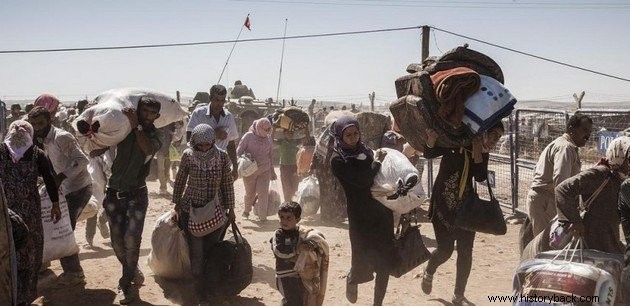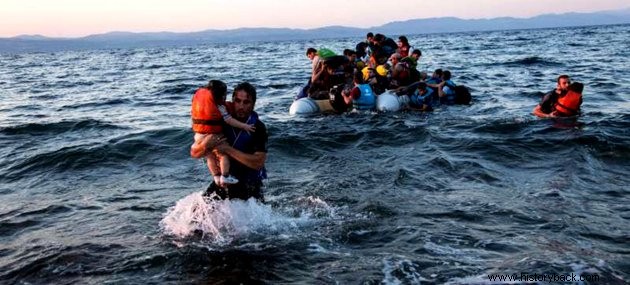The War in Syria began in 2011, within the context of the Arab Spring when there was a series of protests against the government of Bashar al-Assad (1965).
The war took a heavy toll on an estimated civilian population of more than 24 million people in the first five years and is not over yet.
Reason for the War in Syria
The war in Syria was triggered after the allegations of corruption revealed by WikiLeaks.
In March 2011, protests took place in the south of Derra in favor of democracy. The population revolted against the arrest of teenagers who wrote revolutionary words on the walls of a school.
In response to the protest, the government ordered security forces to open fire on protesters causing several deaths. The population revolted against the repression and demanded the resignation of President Bashar al-Assad.
The Middle East and North Africa region was rocked by a wave of anti-government protests that became known as the Arab Spring.
In some cases, such as Libya, the country's top leader was removed. However, the Syrian president responded with violence and used the army to repress the protesters.
In turn, the opposition begins to arm itself and fight the security forces. Brigades formed by rebels begin to control cities, countryside and villages, supported by Western countries such as the United States, France, Canada, etc.

Both sides of the conflict begin to impose a food blockade on civilians. Access to water is also interrupted or limited. On several occasions, humanitarian forces are prevented from entering the conflict zone.
In addition, the Islamic State takes advantage of the country's fragility and sets out to conquer important cities in Syrian territory.
Survivors report that harsh punishments are imposed on those who do not accept their rules. Among them are:beatings, gang rapes, public executions and mutilations.
See also:Civil WarBelligerent Forces in the Syrian War
It is necessary to understand that four distinct forces act in the conflict:
- Syrian Arab Republic – led by President Bashar al-Assad, the Syrian Armed Forces try to keep the president in power and face three distinct enemies. It is supported by Iraq, Iran, Lebanese Hezbollah and Russia.
- Free Syrian Army – is formed by several groups that rebelled against Bashar al-Assad after the beginning of the conflict in 2011. They receive support from Turkey, Saudi Arabia and Qatar.
- Democratic Union Party – formed by the Kurds, this armed group claims the autonomy of the Kurdish people within Syria. In this way, Iraqi Kurds and Turks became involved in this struggle. Both the Free Syrian Army and the Kurds receive support from the United States, European Union, Australia, Canada, etc. However, President Barack Obama and his successor, Trump, refuse to intervene militarily in the region.
- Islamic State – its main objective is to declare a caliphate in the region. Despite capturing important cities, they were defeated by Western powers.
Furthermore, the conflict is fueled by the sectarian difference between Sunnis and Shiites.
Summary of the War in Syria
July 2011
Thousands of protesters returned to the streets and were repressed by Bashar al-Assad's security forces.
July 2012
The fighting reaches Aleppo, the country's largest city, before the conflict.
The Sunni majority starts to speak out. The importance of the Islamic State jihadist group within the war grows.
June 2013
The UN announces that 90,000 people have died to date as a result of the conflicts.
August 2013
Hundreds die after a rocket drops a chemical agent on the outskirts of Damascus. The government blames the rebels.
June 2014
The Islamic State takes control of part of Syria and Iraq and proclaims the creation of a caliphate, but the attacks cease when the United States threatens to intervene in the conflict.
April to July 2014
The OPCW (Organization for the Prohibition of Chemical Weapons) records the systematic use of chemical weapons.
September 2014
The US-led international coalition launches an air strike against Syria.
Russia launches air strikes and is accused of killing rebels and civilians with Western support.
Political alliances emerge, such as the National Coalition of Revolutionary Syria and the Opposition Forces.
August 2015
Islamic State fighters carry out mass killings, mostly by beheading.
The Islamic State uses chemical weapons in the city of Marea.
March 2016
Al-Assad's forces reconquer the city of Palmyra from the Islamic State. Throughout 2016, some meetings are held between the warring parties in order to achieve peace.
September 2016
Russian forces and Syrian army bomb Aleppo and reconquer. The battle for the city lasted four years and it was an important strategic point, as it is the second most important city in the country.
January 2017
Negotiations that will be known as the "Astana Process" begin when various war actors try to negotiate a ceasefire. The Astana Agreement has only been ratified by Russia, Iran and Turkey, not being ratified by the Syrian government or the opposition in exile.
April 2017
The Syrian army launches a sarin gas attack on the civilian population of the city of Khan Shaykhun on April 4, leaving a hundred dead. In response, for the first time, the United States directly attacks the Syrian base d'Al-Chaayrate by launching missiles.
September 2017
The Syrian Democratic Forces and the Islamic State are fighting for possession of the oil-rich Deir ez-Zor area. The battle continues.
February 2018
On February 18, 2018, Bashar al-Assad's army began to violently attack the Ghouta region, a stronghold that opposes him. It is estimated that more than 300 people were killed during the bombing.
On February 24, 2018, the UN declared a humanitarian pause in order to bring a convoy into the conflict zone of Eastern Guta. Likewise, Russian President Vladimir Putin ordered a five-hour break.
The aim was to deliver medicine, clothing and food to the civilians, about 400,000 who were between the two fighting armies. The ceasefire, however, was not respected by either side, and more deaths occurred.
April 2018
In the first week of April, a chemical weapons attack was carried out in the town of Jan Sheijun. Although it is not known for sure whether it was the Russians or Bashar al-Assad's army that used this weapon, the attack provoked an immediate reaction from France, the United States and the United Kingdom.
In this way, the three countries came together to fight back on April 13, bombing the Duma region. Russia is also doing a huge amount of disinformation, spreading fake news through social media and blogs in order to discredit Western aid.
June 2018
A group of 800 Syrians who were refugees in Lebanon decided to return to their country. A month later, another contingent of 900 people followed suit.
October 2019
US President Donald Trump announces the withdrawal of US troops from northern Turkey.
Immediately, the president of that country, Recep Tayyip Erdogan, begins the attack on the Kurds, alleging that they are attacking Turkish sovereignty.
Syrian War Conflict Figures

- 320,000 to 450,000 people have died in the conflict.
- 1.5 million were injured.
- 6.7 million Syrian refugees, Turkey being the main destination with 3.7 million. (Source:UNHCR/2019)
- Brazil, by 2018, had granted entry to 3,326 Syrians. (Source:Ministry of Justice and Public Security)
- Libya is home to 1.5 million Syrian refugees who make up 25% of its population.
- 6.5 million people were internally displaced.
- 1.2 million Syrians were forced to leave their homes in 2015 alone.
- Oil production was 385,000 barrels a day in 2010, but in 2017 it was 8,000 barrels a day.
- 60.2% of the territory is controlled by the Syrian Army. The rest of the territory is divided between the Islamic State, Kurds and the Syrian Democratic Forces. (Source:EFE Agency/2019)
- 70% of the population does not have access to safe drinking water.
- 2 million children are out of school.
- Before the war, the Syrian population was 24.5 million. It is now estimated to be 17.9 million.
- Poverty affects 80% of the population, who do not have access to basic food.
- 15,000 soldiers from 80 nations are on the front lines of the conflict.
Complete your studies with these texts :
- Refugees
- Middle East
- Vietnam War
